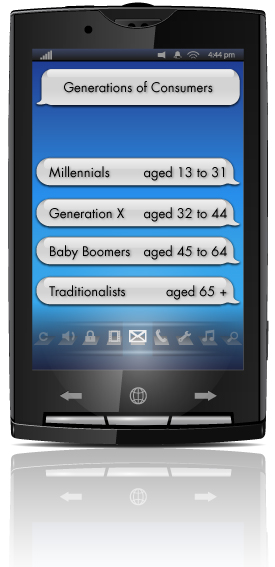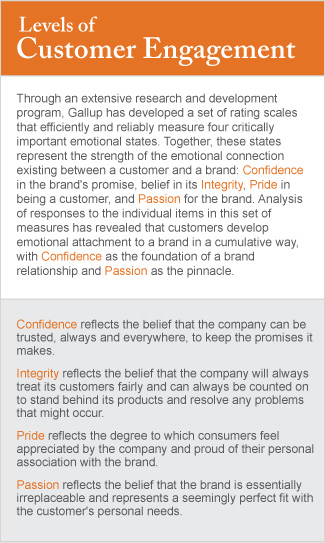Here, in fewer than 140 characters, is what you want young consumers to tweet to their followers:
OMG! Awesome! U have 2 buy this!
Welcome to the marketing world of the Millennial generation. Every generation of shoppers forces retailers to bring a fresh perspective to the customer landscape -- and this is particularly true for the children of the Baby Boomers. The monikers used to identify this powerful segment of consumers -- Millennials, Generation Y, Echo Boomers -- vary almost as much as their shopping habits and preferences. Yet this group represents a distinct force, one that's strong enough to shape economic landscapes for decades.
Recent Gallup research finds that Millennials -- or consumers aged 13 to 31 -- are more likely than other generational groups to have shopped for themselves in stores and online for clothing and accessories in the past three months. They averaged about three and a half purchases for these types of items during the same three-month timeframe, outpacing every other age group. They spent less during those three months on clothing and accessories than did Baby Boomers and Traditionalists and about the same as Gen Xers.
Millennials are fickle fashionistas. While they shop more frequently than other generational groups, they don't spend as much as Baby Boomers and Traditionalists. They are also less likely than the two oldest generational groups to say that the quality of clothing is more important to them than the price.
"Millennials are among the savviest of shoppers, and they're poised to spend more on their purchases as the generation evolves further," says Kurt Deneen, a Gallup consultant. "They are more likely than other age groups to be unique. They see clothing as making a statement about themselves as individuals."
The next generation of shoppers
Millennials use a variety of shopping channels. And this multichannel shopping pattern creates a unique landscape for these consumers and the retailers that target them, Deneen suggests.
This is the generation, he notes, that since childhood, has spent hours each day browsing through digital cable guides stuffed with hundreds of stations with thousands of ads. They've sifted through online marketing since they started surfing the Web, and they're comfortable shopping online and using the Internet to refine their searches, compare prices, and maximize their purchases. And because mobile technology is ubiquitous in this group, Millennials expect access to stores online -- not necessarily to their brick and mortar equivalents.
"It seems as if Millennials see traditional shopping as passé," Deneen says. "The brick and mortar experience is almost a living advertisement for the brand, with Millennials making their purchases increasingly using e-commerce and mobile commerce avenues."
Millennials are constantly looking for new trends, and they're often the first to identify them. And because of their comfort level with social media and e-commerce, these shoppers can quickly communicate about what they want and where to find it. They look for the right styles and the right price, and they have the ability, focus, and technical knowledge to find the right option when they want it. They shop for fashion, they shop for trend, and they shop a variety of stores and brands.
But if Millennial consumers are a moving target, how can retailers create an initial relationship with them and then build it into a engaged one? Can businesses realistically expect this generation of shoppers to establish long-lasting attachments to certain brands? Deneen says retailers can forge ongoing relationships with Millennial customers, but there must be something of value available to Millennials in exchange for their allegiance.
"Retailers can't create engagement with Millennials in passive, 'stop in and shop' interactions. It's all about experience and accessibility," Deneen says. "Speed is life with this generation. They know what they want, and they want it now."
Engage them
Gallup research shows that cost is an important factor when generating engagement among Millennials, as with other generations. Millennials who must make their retail dollars stretch will keep shopping with a brand or retailer if they offer discounts on the items these shoppers want. One successful strategy is to enroll shoppers in loyalty and rewards programs, offering them membership cards and status as preferred clients that often come with discounts and coupons.
Make Millennials think they can't live without your product -- even if they can.

Millennials also want to be informed shoppers. "Millennials, as much as anyone, want to save money. But engagement with the retailer is built on more than cost savings," Deneen says. "It's about being informed of trends, new products, and daily promotions." Many retailers host "flash promotions," a marketing strategy that gets this group's attention. Retailers are inviting customers who follow them on social media to one-day events -- "Come in today, and you'll get 30% off your purchase," for example. These events promote a feeling that these customers enjoy special status with the retailers; they also encourage customers to keep following their favorite retailers using social media, offering an entirely new way to build relationships and engage customers.
Loyalty and preferred customer programs help retailers give a captive fraction of their target audience the discounts and attention to cost those customers crave. But only by fully engaging their shoppers can retailers capture and keep the Millennial marketplace.
Easier said than done, right? Well, consider the makeup of the Millennial shopper, then examine exactly how your brand succeeds or fails based on what this generation of shoppers says is important to them. "Great customer service" is the top driver of retail customer engagement among shoppers, according to Gallup's research. But Millennials are drawn more to places where it is easy to shop; convenience matters almost as much as customer service.
This means offering these shoppers access to product information before they make a purchase, perhaps via outlets usually reserved for Millennials' social networking interactions, Deneen suggests. But he adds that convenience in the in-store experience is also critical; the speed and ease with which Millennials can identify what they want, whether a retailer has it, and purchase it is essential to engaging these choosy consumers.
Consider how Millennial customers might answer these questions about your brand:
-
Do you have what I want?
-
Is it fresh?
-
Is it me?
-
What do my friends think?
Convenience is just one part of the approach to engaging Millennial shoppers. How you answer these four questions will determine if you can engage these consumers with your brand. That's because these questions and their answers relate to the four key elements of customer engagement: Confidence, Integrity, Pride, and Passion. (See sidebar "Levels of Customer Engagement.")
 Communication is critical to convincing these consumers that your product is trendy, fresh, and unique. "Millennials are an informed group, and it is important that retailers lead with access to information as the foundation of engagement with these customers," Deneen says. You have to sell the right product -- or at least the product Millennials think is right for them; you have to make Millennials think they can't live without your product -- even if they can. You can have the best messaging in the marketplace but fail to communicate your point if you're not using the right channels to reach Millennial shoppers.
Communication is critical to convincing these consumers that your product is trendy, fresh, and unique. "Millennials are an informed group, and it is important that retailers lead with access to information as the foundation of engagement with these customers," Deneen says. You have to sell the right product -- or at least the product Millennials think is right for them; you have to make Millennials think they can't live without your product -- even if they can. You can have the best messaging in the marketplace but fail to communicate your point if you're not using the right channels to reach Millennial shoppers.
Many of these individuals cull their information and mindset about almost everything from the seemingly endless social networks they belong to. They find trends by tweet and text and through their Facebook friends. So give your customers a social medium to discuss your products and brand and the ability to share suggestions about what they want. And provide them with multiple mobile and online options for buying and promoting your products.
In the end, Millennials want to see how your product fits in their life. So retailers must interject themselves into the discussion and find opportunities to communicate what their products can do for those shoppers. Brands must meet Millennials where they are; illustrate how the products are made for them; and create a trusting, genuine relationship between brand and consumer.
Survey Methods
Results are based on a Gallup Panel study and are based on mail and web surveys completed by 44,162 national adults, aged 16 and older, conducted in April and May 2009. Gallup Panel members are recruited through random selection methods. The panel is weighted so that it is demographically representative of the U.S. adult population. For results based on this sample, one can say with 95% confidence that the maximum margin of sampling error is ±1.0 percentage points. Margins of sampling errors vary for individual subsamples. In addition to sampling error, question wording and practical difficulties in conducting surveys can introduce error or bias into the findings of public opinion polls.
